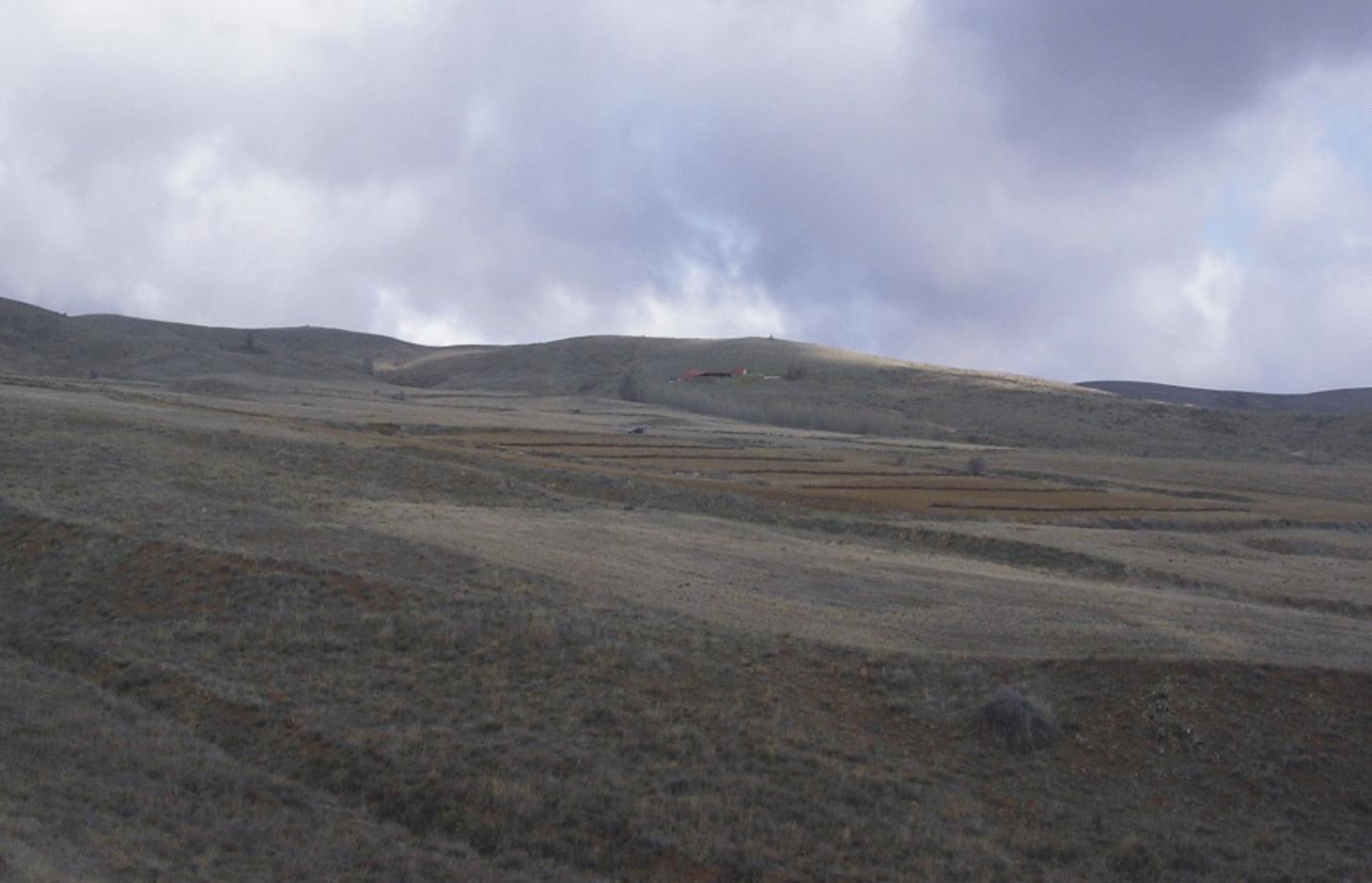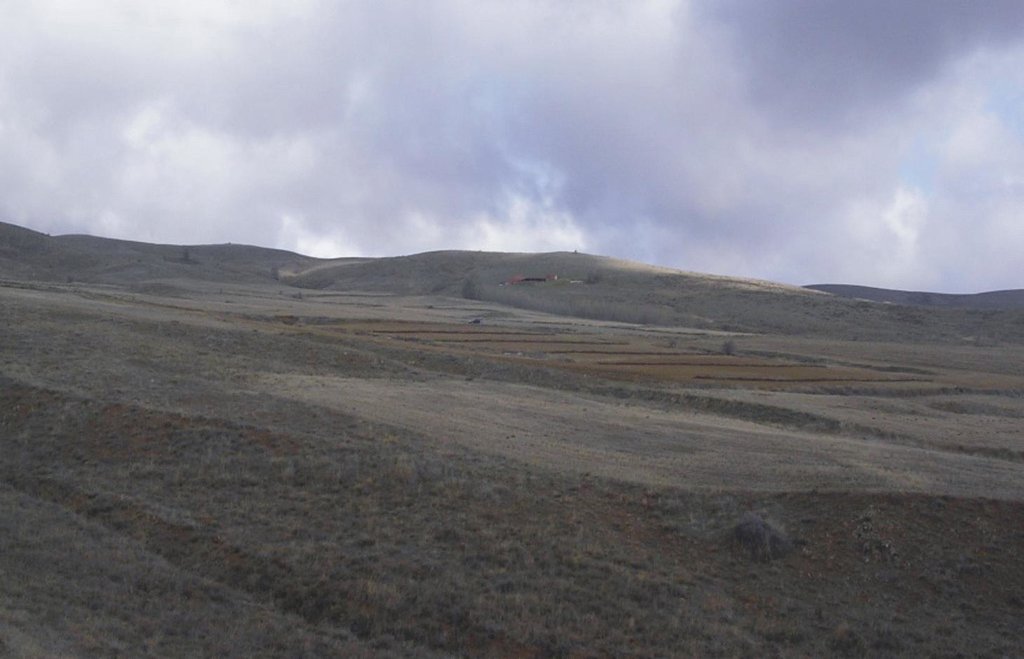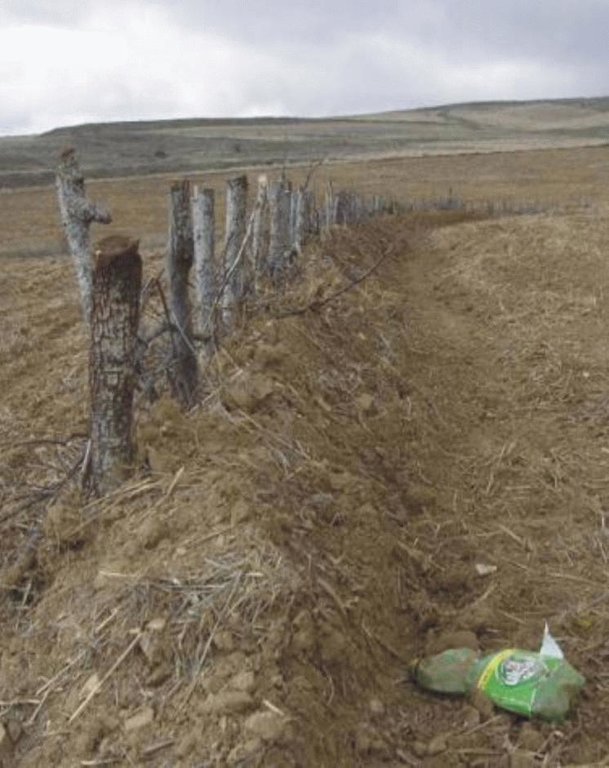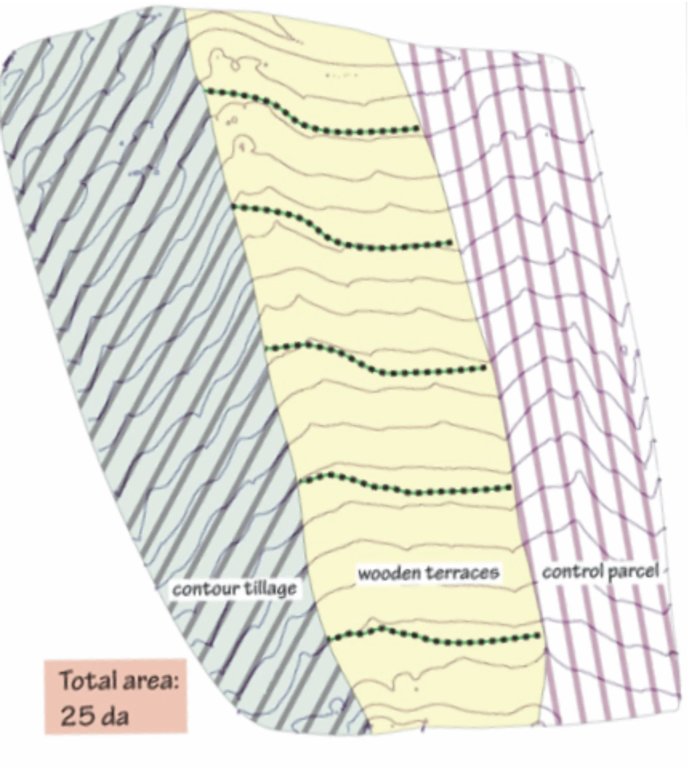Woven Wood Fences [土耳其]
- 创建:
- 更新:
- 编制者: Faruk Ocakoglu
- 编辑者: –
- 审查者: Deborah Niggli, Alexandra Gavilano
Odundan Örme Çitler (Turkish)
technologies_1535 - 土耳其
查看章节
全部展开 全部收起1. 一般信息
1.2 参与该技术评估和文件编制的资源人员和机构的联系方式
SLM专业人员:
Inci Tolay
Akadeniz University
土耳其
有助于对技术进行记录/评估的项目名称(如相关)
DESIRE (EU-DES!RE)有助于对技术进行记录/评估的机构名称(如相关)
Eskişehir Osmangazi University, Faculty of Engineering and Architecture - Türkiye有助于对技术进行记录/评估的机构名称(如相关)
Akdeniz Üniversity (Akdeniz Üniversity) - Türkiye1.3 关于使用通过WOCAT记录的数据的条件
编制者和关键资源人员接受有关使用通过WOCAT记录数据的条件。:
是
2. SLM技术的说明
2.1 技术简介
技术定义:
Wooden fences are an effective and relatively cheap way of conserving soil from water erosion by decreasing overland flow. They also increase crop yield by encouraging better infiltration.
2.2 技术的详细说明
说明:
Dry croplands in semi-arid regions are generally subjected to intense soil erosion in hillslopes due to sudden heavy rainfalls. In these areas, conserving soil and water by cheap technologies that could be installed by the farmers with available resources and knowledge becomes important.
Purpose of the Technology: Woven wood fences represent a technology applied and demonstrated successful in semi-arid mountainous dry croplands in Eskişehir, central Anatolia. They consist of wooden posts 150 cm height inserted into the ground and branches woven between these posts. Eroded soil from upslope becomes trapped on the upslope side of the fence and overland flow is decreased. The distance between the fences is determined with respect to soil texture and field gradient. It is 30 m in hillslopes of 10% gradient covered by sandy loams in the Eskişehir region.
Establishment / maintenance activities and inputs: The basic costs are for the materials, its transportation and the labour involved in installation. The posts and branches are derived either from trees on the farmers’ fields or from nearby state-owned forests. For 2009, the cost of installation was about 1350 US$/ha. The maintenance costs of this medium-term (20 years) technology are only the labour needed to repair the damaged fences/terraces after extreme rainfalls. Technological change includes contour (rather than downslope) tillage between the fences, which causes a minor increase (10%) in the expenses of tillage operations.
Natural / human environment: The technology can be applied both by small- and large-scale farmers in quite different soil and slope gradient conditions. Results indicate that crop yield doubles (1300 kg/ha of barley) and soil loss apparently diminishes using this technology.
2.3 技术照片
2.5 已应用该技术的、本评估所涵盖的国家/地区/地点
国家:
土耳其
区域/州/省:
Central Anatolia
有关地点的进一步说明:
Eğriöz village, Eskişehir
注释:
Total area covered by the SLM Technology is 0.0115 km2.
2.6 实施日期
如果不知道确切的年份,请说明大概的日期:
- 不到10年前(最近)
2.7 技术介绍
详细说明该技术是如何引入的:
- 在实验/研究期间
- 通过项目/外部干预
3. SLM技术的分类
3.2 应用该技术的当前土地利用类型

农田
- 一年一作
具体说明:
Longest growing period in days: 220Longest growing period from month to month: Nov - Jun

森林/林地
产品和服务:
- 薪材
注释:
Major land use problems (compiler’s opinion): The current dry cropland use requires the fields to be fallow every second year due to insufficient water in the soil. For this reason drought radically decreases crop yield. Owing to heavy rainfall, removal of both topsoil and subsoil occurs in places causing increased stoniness in the soil, which decreases its fertility and makes the tillage operations difficult.
3.5 该技术所属的SLM组
- 横坡措施
3.6 包含该技术的可持续土地管理措施

结构措施
- S6:墙、障碍物、栅栏、围墙
注释:
Main measures: structural measures
3.7 该技术强调的主要土地退化类型

土壤水蚀
- Wt:表土流失/地表侵蚀
注释:
Main type of degradation addressed: Wt: loss of topsoil / surface erosion
Main causes of degradation: soil management, crop management (annual, perennial, tree/shrub), droughts, poverty / wealth, lack of knowledge
3.8 防止、减少或恢复土地退化
具体数量名该技术与土地退化有关的目标:
- 防止土地退化
注释:
Main goals: prevention of land degradation
4. 技术规范、实施活动、投入和成本
4.1 该技术的技术图纸
技术规范(与技术图纸相关):
Plan of the site implementation in Eskişehir. Solid lines depict contours at 1 m intervals.
The implementation area (at the centre of the Figure on the left) has a gradient of 10 %. Fence spacing is 30 m and each fence is 60 m long. Posts provide the strength of the structure and are inserted up to 30 cm into the ground. Branches are woven between the posts. Eroded soil trapped on the upslope side produces an earth bank.
Technical knowledge required for field staff / advisors: high
Technical knowledge required for land users: moderate
Main technical functions: control of dispersed runoff: retain / trap, reduction of slope length
Secondary technical functions: increase in organic matter, increase of infiltration, increase / maintain water stored in soil
4.3 技术建立活动
| 活动 | 时间(季度) | |
|---|---|---|
| 1. | Building the fences (providing wooden material, excavations, terracing) |
4.4 技术建立所需要的费用和投入
| 对投入进行具体说明 | 单位 | 数量 | 单位成本 | 每项投入的总成本 | 土地使用者承担的成本% | |
|---|---|---|---|---|---|---|
| 劳动力 | Labour | ha | 1.0 | 550.0 | 550.0 | 10.0 |
| 施工材料 | Wood | ha | 1.0 | 600.0 | 600.0 | |
| 其它 | Transportation, Oil | ha | 1.0 | 200.0 | 200.0 | 90.0 |
| 技术建立所需总成本 | 1350.0 | |||||
| 技术建立总成本,美元 | 1350.0 | |||||
4.5 维护/经常性活动
| 活动 | 时间/频率 | |
|---|---|---|
| 1. | Repair of fences |
4.6 维护/经常性活动所需要的费用和投入(每年)
| 对投入进行具体说明 | 单位 | 数量 | 单位成本 | 每项投入的总成本 | 土地使用者承担的成本% | |
|---|---|---|---|---|---|---|
| 劳动力 | Labour | ha | 1.0 | 100.0 | 100.0 | 100.0 |
| 施工材料 | Wood | ha | 1.0 | 10.0 | 10.0 | 100.0 |
| 技术维护所需总成本 | 110.0 | |||||
| 技术维护总成本,美元 | 110.0 | |||||
注释:
In the account above, we do not consider regular cropping activities (ploughing, tillage, fertilization etc.) but only the basic costs of the new technology.
5. 自然和人文环境
5.1 气候
年降雨量
- < 250毫米
- 251-500毫米
- 501-750毫米
- 751-1,000毫米
- 1,001-1,500毫米
- 1,501-2,000毫米
- 2,001-3,000毫米
- 3,001-4,000毫米
- > 4,000毫米
农业气候带
- 半干旱
Thermal climate class: temperate
5.2 地形
平均坡度:
- 水平(0-2%)
- 缓降(3-5%)
- 平缓(6-10%)
- 滚坡(11-15%)
- 崎岖(16-30%)
- 陡峭(31-60%)
- 非常陡峭(>60%)
地形:
- 高原/平原
- 山脊
- 山坡
- 山地斜坡
- 麓坡
- 谷底
垂直分布带:
- 0-100 m a.s.l.
- 101-500 m a.s.l.
- 501-1,000 m a.s.l.
- 1,001-1,500 m a.s.l.
- 1,501-2,000 m a.s.l.
- 2,001-2,500 m a.s.l.
- 2,501-3,000 m a.s.l.
- 3,001-4,000 m a.s.l.
- > 4,000 m a.s.l.
5.3 土壤
平均土层深度:
- 非常浅(0-20厘米)
- 浅(21-50厘米)
- 中等深度(51-80厘米)
- 深(81-120厘米)
- 非常深(> 120厘米)
土壤质地(表土):
- 中粒(壤土、粉土)
表土有机质:
- 低(<1%)
如有可能,附上完整的土壤描述或具体说明可用的信息,例如土壤类型、土壤酸碱度、阳离子交换能力、氮、盐度等。:
Soil fertility is: Low
Soil drainage/infiltration is: Good
Soil water storage capacity is: Medium
5.4 水资源可用性和质量
地下水位表:
5-50米
地表水的可用性:
匮乏/没有
水质(未处理):
良好饮用水
5.5 生物多样性
物种多样性:
- 中等
5.6 应用该技术的土地使用者的特征
生产系统的市场定位:
- 混合(生计/商业)
相对财富水平:
- 贫瘠
个人或集体:
- 个人/家庭
说明土地使用者的其他有关特征:
Land users applying the Technology are mainly disadvantaged land users
Population density: 10-50 persons/km2
Annual population growth: 0.5% - 1%
50% of the land users are poor and own 20% of the land.
Off-farm income specification: as high as 30% of all income
5.7 应用该技术的土地使用者使用的平均土地面积
- < 0.5 公顷
- 0.5-1 公顷
- 1-2 公顷
- 2-5公顷
- 5-15公顷
- 15-50公顷
- 50-100公顷
- 100-500公顷
- 500-1,000公顷
- 1,000-10,000公顷
- > 10,000公顷
这被认为是小规模、中规模还是大规模的(参照当地实际情况)?:
- 小规模的
5.8 土地所有权、土地使用权和水使用权
土地所有权:
- 个人,有命名
土地使用权:
- 个人
用水权:
- 个人
5.9 进入服务和基础设施的通道
健康:
- 贫瘠
- 适度的
- 好
教育:
- 贫瘠
- 适度的
- 好
技术援助:
- 贫瘠
- 适度的
- 好
就业(例如非农):
- 贫瘠
- 适度的
- 好
市场:
- 贫瘠
- 适度的
- 好
能源:
- 贫瘠
- 适度的
- 好
饮用水和卫生设施:
- 贫瘠
- 适度的
- 好
金融服务:
- 贫瘠
- 适度的
- 好
6. 影响和结论性说明
6.1 该技术的现场影响
社会经济效应
生产
作物生产
畜牧生产
生产区域
水资源可用性和质量
灌溉用水需求
收入和成本
农业收入
工作量
社会文化影响
食品安全/自给自足
SLM/土地退化知识
冲突缓解
Improved livelihoods and human well-being
注释/具体说明:
The technology produces a large crop yield increase and also conserves soil and water. As a result it increases farm income considerably.
生态影响
水循环/径流
水的回收/收集
6.2 该技术的场外影响已经显现
下游淤积
对邻近农田的破坏
6.3 技术对渐变气候以及与气候相关的极端情况/灾害的暴露和敏感性(土地使用者认为的极端情况/灾害)
其他气候相关的后果
其他气候相关的后果
| 该技术是如何应对的? | |
|---|---|
| medium-low intensity rainfall | 好 |
6.4 成本效益分析
技术收益与技术建立成本相比如何(从土地使用者的角度看)?
短期回报:
中性/平衡
长期回报:
非常积极
技术收益与技术维护成本/经常性成本相比如何(从土地使用者的角度看)?
短期回报:
非常积极
长期回报:
非常积极
6.5 技术采用
如若可行,进行量化(住户数量和/或覆盖面积):
1
注释:
100% of land user families have adopted the Technology with external material support
1 land user families have adopted the Technology with external material support
Comments on spontaneous adoption: Farmers expect state subsidies for further adoption of technology.
6.7 该技术的优点/长处/机会
| 编制者或其他关键资源人员认为的长处/优势/机会 |
|---|
|
Increase in crop yield How can they be sustained / enhanced? Rotational cropping may further increase the yield |
|
Increase in farm income How can they be sustained / enhanced? Cropping new species tolerant to drought |
6.8 技术的弱点/缺点/风险及其克服方法
| 编制者或其他关键资源人员认为的弱点/缺点/风险 | 如何克服它们? |
|---|---|
| Small parcels left in the very borders of the terraces cause a loss of field | Smaller tractors with more manoeuvre capability |
7. 参考和链接
7.1 信息的方法/来源
7.2 参考可用出版物
标题、作者、年份、ISBN:
Gates J. B., Scanlon B. R., Mu, X., Zhang, L., 2011. Impacts of soil conservation on groundwater recharge in the semi-arid Loess Plateau, China. Hydrogeology Journal, 19: 865–875.
可以从哪里获得?成本如何?
Hydrogeology Journal, 19: 865–875.
标题、作者、年份、ISBN:
Ağaçlandırma ve Erozyon Kontrolü Genel Müdürlüğü, 2011. Su Erzoyonu ile Mücadele.
可以从哪里获得?成本如何?
http://www.agm.gov.tr/AGM/AnaSayfa/faliyetler/erozyon
7.3 链接到网络上的相关信息
标题/说明:
Ağaçlandırma ve Erozyon Kontrolü Genel Müdürlüğü, 2011. Su Erzoyonu ile Mücadele.
URL:
http://www.agm.gov.tr/AGM/AnaSayfa/faliyetler/erozyon
链接和模块
全部展开 全部收起链接
无链接
模块
无模块





